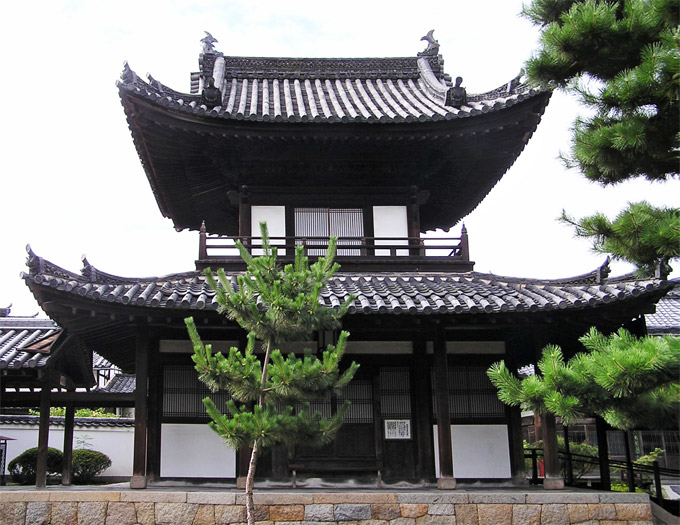|
||
 |
||

Manpukuji
Korou 萬福寺鼓楼 (Kyoto)
(C)2001 Japanese Architecture and Art Net Users System. No reproduction or republication without written permission.
掲載のテキスト・写真・イラストなど、全てのコンテンツの無断複製・転載を禁じます。
|
||||||
| korou 鼓楼 | ||||||
| KEY WORD : architecture / buildings & structures | ||||||
| A small, two-storied structure *rou-zukuri 楼造, in which a drum is suspended in the upper part. The main purpose of the drum was for indicating the time for the priests and monks living at Buddhist temples. Sometimes it also served as a sutra repository as is the case with the Korou at Toushoudaiji 唐招提寺 (1240) in Nara. This building has a raised plank floor with a simple railing surrounding the shallow veranda. The ground floor of the building is 3x2 bays (5.42 x 6.25m). The entrances are on the long side and take up the entire width of the center bays. The bracket complexes on the first story are 3-on-1 at right angles to each other *demitsudo 出三斗, and they support the upper story veranda, which is also surrounded by the same simple railing as the first story. The upper story has 1-stepped bracket complexes *degumi 出組. On both stories the interstices have struts capped with bearing blocks *kentozuka 間斗束, which are centered to help bear the weight from above. The roof is hip-and-gable *irimoya-zukuri 入母屋造, and tiled *hongawarabuki 本瓦葺. The windows are filled with vertical laths. The use of reinforcing rafters chikaradaruki 力垂木, is unusual. This type of korou was not entirely abandoned as is exemplified by the Korou (1668) at Manpukuji 萬福寺 in Kyoto and by the combination belfry, *Shourou 鐘楼 and Korou at Soufukuji Shoukorou 崇福寺鐘鼓楼 in Nagasaki prefecture. However drum towers began to be constructed as a single story building with the lower part resembling a flared skirt, a style called *hakamagoshi 袴腰, which had been used for belfries from the late Heian period. | ||||||
 Manpukuji
Korou 萬福寺鼓楼 (Kyoto)
|
||||||
| REFERENCES: | ||||||
| EXTERNAL LINKS: | ||||||
| NOTES: | ||||||
(C)2001 Japanese Architecture and Art Net Users System. No reproduction or republication without written permission. 掲載のテキスト・写真・イラストなど、全てのコンテンツの無断複製・転載を禁じます。 |
||||||